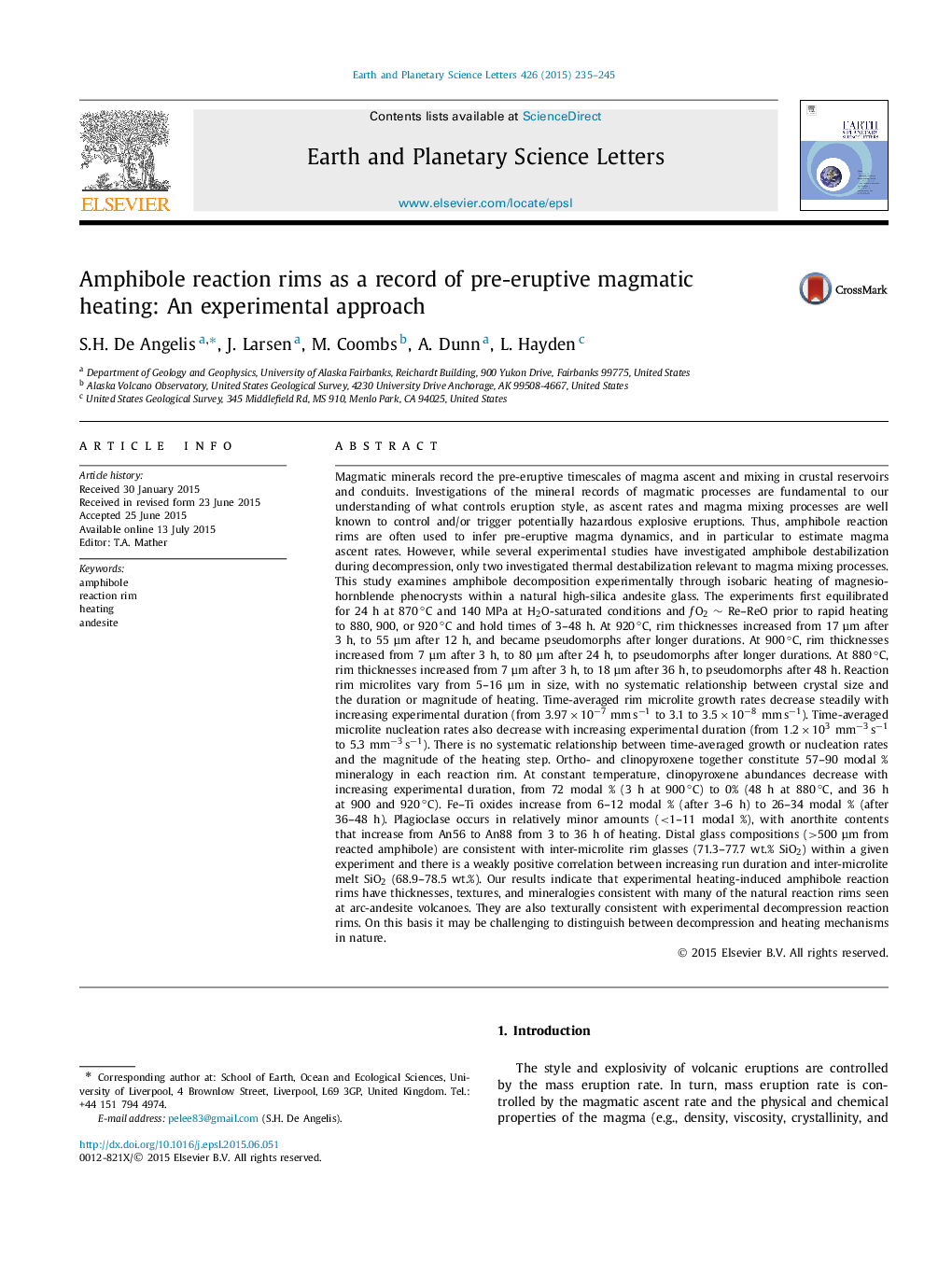| کد مقاله | کد نشریه | سال انتشار | مقاله انگلیسی | نسخه تمام متن |
|---|---|---|---|---|
| 6428139 | 1634730 | 2015 | 11 صفحه PDF | دانلود رایگان |
عنوان انگلیسی مقاله ISI
Amphibole reaction rims as a record of pre-eruptive magmatic heating: An experimental approach
ترجمه فارسی عنوان
رینگ های واکنش آمفیبول به عنوان یک رکورد گرمای ماگمایی پیش فوران کننده: یک رویکرد تجربی
دانلود مقاله + سفارش ترجمه
دانلود مقاله ISI انگلیسی
رایگان برای ایرانیان
کلمات کلیدی
آمفیبول، واکنش لبه، حرارت دادن، آندزیت،
موضوعات مرتبط
مهندسی و علوم پایه
علوم زمین و سیارات
علوم زمین و سیاره ای (عمومی)
چکیده انگلیسی
Magmatic minerals record the pre-eruptive timescales of magma ascent and mixing in crustal reservoirs and conduits. Investigations of the mineral records of magmatic processes are fundamental to our understanding of what controls eruption style, as ascent rates and magma mixing processes are well known to control and/or trigger potentially hazardous explosive eruptions. Thus, amphibole reaction rims are often used to infer pre-eruptive magma dynamics, and in particular to estimate magma ascent rates. However, while several experimental studies have investigated amphibole destabilization during decompression, only two investigated thermal destabilization relevant to magma mixing processes. This study examines amphibole decomposition experimentally through isobaric heating of magnesio-hornblende phenocrysts within a natural high-silica andesite glass. The experiments first equilibrated for 24 h at 870â°C and 140 MPa at H2O-saturated conditions and ÆO2 â¼ Re-ReO prior to rapid heating to 880, 900, or 920â°C and hold times of 3-48 h. At 920â°C, rim thicknesses increased from 17 μm after 3 h, to 55 μm after 12 h, and became pseudomorphs after longer durations. At 900â°C, rim thicknesses increased from 7 μm after 3 h, to 80 μm after 24 h, to pseudomorphs after longer durations. At 880â°C, rim thicknesses increased from 7 μm after 3 h, to 18 μm after 36 h, to pseudomorphs after 48 h. Reaction rim microlites vary from 5-16 μm in size, with no systematic relationship between crystal size and the duration or magnitude of heating. Time-averaged rim microlite growth rates decrease steadily with increasing experimental duration (from 3.97Ã10â7 mmsâ1 to 3.1 to 3.5Ã10â8 mmsâ1). Time-averaged microlite nucleation rates also decrease with increasing experimental duration (from 1.2Ã103 mmâ3sâ1 to 5.3 mmâ3âsâ1). There is no systematic relationship between time-averaged growth or nucleation rates and the magnitude of the heating step. Ortho- and clinopyroxene together constitute 57-90 modal % mineralogy in each reaction rim. At constant temperature, clinopyroxene abundances decrease with increasing experimental duration, from 72 modal % (3 h at 900â°C) to 0% (48 h at 880â°C, and 36 h at 900 and 920â°C). Fe-Ti oxides increase from 6-12 modal % (after 3-6 h) to 26-34 modal % (after 36-48 h). Plagioclase occurs in relatively minor amounts (<1-11 modal %), with anorthite contents that increase from An56 to An88 from 3 to 36 h of heating. Distal glass compositions (>500 μm from reacted amphibole) are consistent with inter-microlite rim glasses (71.3-77.7 wt.% SiO2) within a given experiment and there is a weakly positive correlation between increasing run duration and inter-microlite melt SiO2 (68.9-78.5 wt.%). Our results indicate that experimental heating-induced amphibole reaction rims have thicknesses, textures, and mineralogies consistent with many of the natural reaction rims seen at arc-andesite volcanoes. They are also texturally consistent with experimental decompression reaction rims. On this basis it may be challenging to distinguish between decompression and heating mechanisms in nature.
ناشر
Database: Elsevier - ScienceDirect (ساینس دایرکت)
Journal: Earth and Planetary Science Letters - Volume 426, 15 September 2015, Pages 235-245
Journal: Earth and Planetary Science Letters - Volume 426, 15 September 2015, Pages 235-245
نویسندگان
S.H. De Angelis, J. Larsen, M. Coombs, A. Dunn, L. Hayden,
